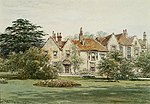The Tower House, 29 Melbury Road, is a late-Victorian townhouse in the Holland Park district of Kensington and Chelsea, London, built by the architect and designer William Burges as his home. Designed between 1875 and 1881, in the French Gothic Revival style, it was described by the architectural historian J. Mordaunt Crook as "the most complete example of a medieval secular interior produced by the Gothic Revival, and the last". The house is built of red brick, with Bath stone dressings and green roof slates from Cumbria, and has a distinctive cylindrical tower and conical roof. The ground floor contains a drawing room, a dining room and a library, while the first floor has two bedrooms and an armoury. Its exterior and the interior echo elements of Burges's earlier work, particularly the McConnochie House in Cardiff and Castell Coch. It was designated a Grade I listed building in 1949.
Burges bought the lease on the plot of land in 1875. The house was built by the Ashby Brothers, with interior decoration by members of Burges's long-standing team of craftsmen such as Thomas Nicholls and Henry Stacy Marks. By 1878 the house was largely complete, although interior decoration and the designing of numerous items of furniture and metalwork continued until Burges's death in 1881. The house was inherited by his brother-in-law, Richard Popplewell Pullan. It was later sold to Colonel T. H. Minshall and then, in 1933, to Colonel E. R. B. Graham. The poet John Betjeman inherited the remaining lease in 1962 but did not extend it. Following a period when the house stood empty and suffered vandalism, it was purchased and restored, first by Lady Jane Turnbull, later by the actor Richard Harris and then by the musician Jimmy Page.
The house retains most of its internal structural decoration, but much of the furniture, fittings and contents that Burges designed has been dispersed. Many items, including the Great Bookcase, the Zodiac settle, the Golden Bed and the Red Bed, are now in museums such as the Ashmolean in Oxford, the Higgins in Bedford and the Victoria and Albert in London, while others are in private collections.












